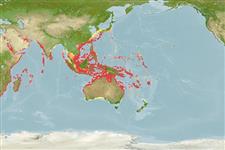Classification / Names
Common names from other countries
Main reference
Size / Weight / Age
Max length : 60.0 cm TL male/unsexed; (Ref. 4787)
Length at first maturity
Lm ?, range 34 - ? cm
Environment
Marine; reef-associated; non-migratory; depth range 3 - 60 m (Ref. 68964), usually 3 - 60 m (Ref. 5222)
Climate / Range
Tropical, preferred 27°C (Ref. 107945); 36°N - 36°S, 27°E - 180°E (Ref. 5222)
Distribution
Indo-West Pacific: Red Sea to South Africa and east to the Gilbert Islands. Probably found in all tropical islands of the Indian Ocean. Also reported from Persian Gulf (Ref. 68964). Recorded from Europa Island (MNHN 1992-0475, Ref. 33390).
Countries | FAO areas | Ecosystems | Occurrences | Introductions
Short description
Dorsal
spines
(total): 9;
Dorsal
soft rays
(total): 17-18;
Anal
spines: 3;
Anal
soft rays: 8 - 9. Dark brown to black in color, occasionally with an orange cast (Ref 5222); color in market is dark brown without distinguishing marks (Ref. 89707); Inside of this grouper's mouth ranges from light pink to crimson. Juveniles have a white border on the caudal fin (Ref. 37816); further characterized by having relatively deep body; greatest depth 2.1-2.4 in SL; width 2.3-2.8 times in depth (Ref. 89707); truncate caudal fin; longest pectoral rays fifth or sixth (Ref. 90102); head length 2.5-2.7 times in SL; convex interorbital area; dorsal head profile steep, straight or slightly concave along the snout and distinctly convex from eye to dorsal fin; preorbital depth 6.5-9.2 times in HL; finely serrate preopercle, fleshy lower edge; smooth subopercle and interopercle or with minute serrae; opercle with three flat spines, middle one closer to the lower spine; upper edge of operculum convex; posterior nostril round or oval; maxilla reaches past eye; ventro-posterior corner of maxilla with distinct bony protuberance; slender supramaxilla; small canine at front of jaws, none elsewhere; 2-4 rows of small slender teeth at side of lower jaw; presence of palatine teeth; well-developed scaly flap of skin joining upper pectoral-fin rays to body; pectoral fins asymmetrical; pelvic fins subequal to pectoral fins, reaching to or beyond anus; caudal fin with 8 branched rays and 9 procurrent rays in upper part and 7 branched rays and 8 procurrent rays in lower part; body scales ctenoid, with auxiliary scales (Ref. 89707).
IUCN Red List Status (Ref. 115185)
Threat to humans
Harmless
Human uses
Fisheries: minor commercial; gamefish: yes
More information
ReferencesAquacultureAquaculture profileStrainsGeneticsAllele frequenciesHeritabilityDiseasesProcessingMass conversion
Tools
Special reports
Download XML
Internet sources
Estimates of some properties based on models
Phylogenetic diversity index
PD50 = 1.0000 many relatives (e.g. carps) 0.5 - 2.0 few relatives (e.g. lungfishes)
Trophic Level
4.2 ±0.71 se; Based on food items.
Resilience
Medium, minimum population doubling time 1.4 - 4.4 years (Preliminary K or Fecundity.)
Vulnerability
Moderate to high vulnerability (49 of 100)
Price category
